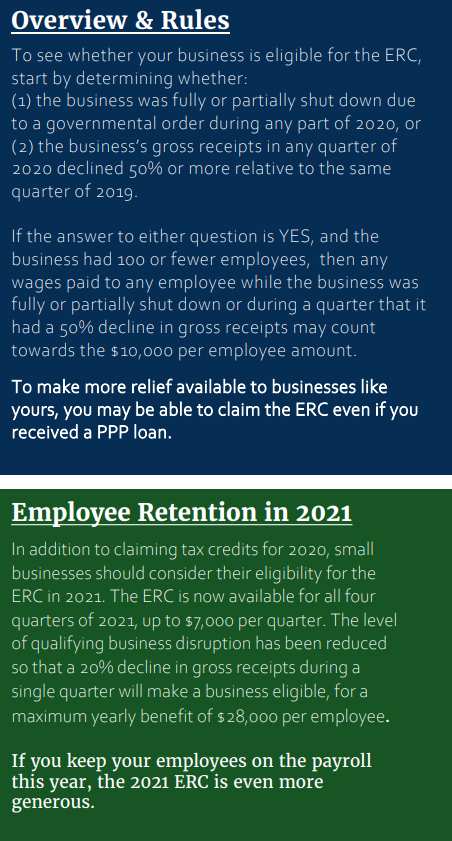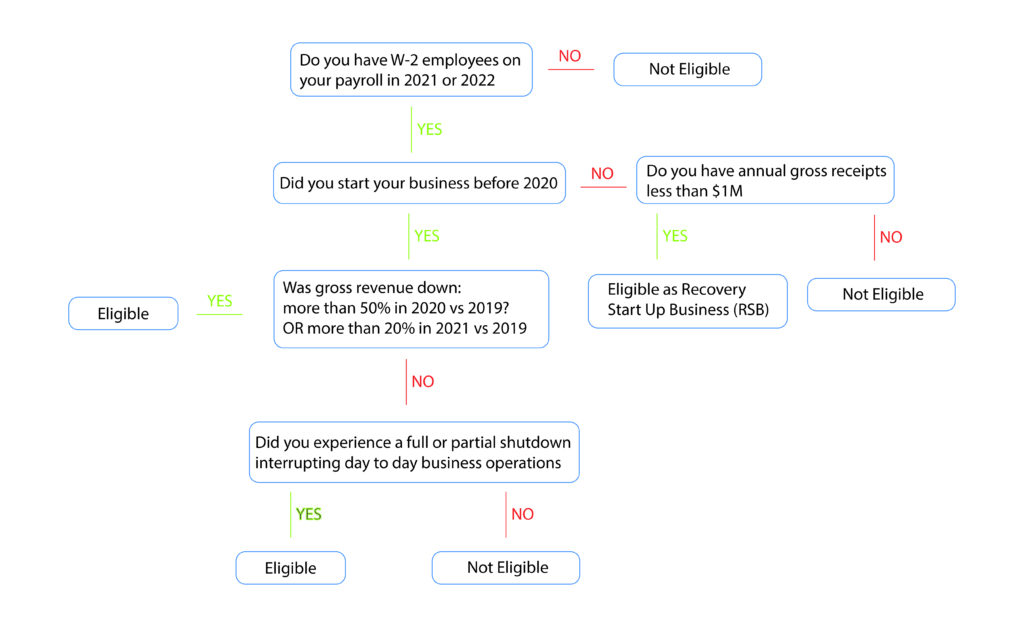Maximize Your Employee
Retention Tax Credit

Fill Out the Form to Get Pre-Qualified
in 1 minute (7 Questions)!
No Up-front Cost to Apply
Companies can still qualify for up to $26,000 per employee. PPP loan recipients are eligible! Apply now, before time runs out.
Ready to Apply? Check out what you documents you need.
Completing the application typically takes around 15-20 minutes, provided you have all necessary information readily available. If you wish, feel free to schedule an appointment with our ERC Specialist who can guide you through the process
The ERTC is a payroll tax refund.
The Employee Retention Tax Credit (ERTC) is a payroll tax refund from the US Treasury to provide aid to businesses that kept employees during the pandemic. The ERTC was enacted as part of the Coronavirus Aid, Relief, and Economic Security (CARES) Act.
Qualified employers can claim up to $26,000 for each employee.
2020
Q2-Q4
$5,000
Per Employee
2021
Q1
$7,000
Per Employee
2021
Q2
$7,000
Per Employee
2021
Q3
$7,000
Per Employee
Total
2021
$26,000
Per Employee
Claiming a Paycheck Protection Program (PPP) loan does not disqualify you from the ERTC.
Business owners have up to five years to file an amended tax return and retroactively claim the ERTC. Don’t miss out on this valuable tax tool to help your business regain its post-pandemic footing.
$67M
Total ERC funds Flex has
claimed for clients
$200,000
Average ERTC payout
for qualified businesses
15 min
Average time it takes to
qualify your business
This is an EITHER / OR test!
A business must satisfy only one of the following either/or
conditions below in order to claim the credit:
Reduction in revenues
2020: Gross receipts in any quarter must be less than 50% as compared to the same quarter of 2019.
2021: A drop of at least 20% in quarterly gross receipts in any quarter as compared to the same quarter in 2019.
- Full or partial shutdown
- Reduction in operating hours
- Supply chain disruptions
- Inability to work onsite or visit clients
- Distribution interruptions

Startups can claim this tax credit, too!
Congress included a provision for Recovery Start Up Businesses (RSBs) as part of the American Rescue Act. RSBs are defined as businesses that:
1- Were incorporated after 2/15/2020;
2- Do not have annual gross receipts of over $1M; and
3- Are not eligible for the ERTC under the partial or full suspension or drop in revenue.
1- Were incorporated after 2/15/2020;
2- Do not have annual gross receipts of over $1M; and
3- Are not eligible for the ERTC under the partial or full suspension or drop in revenue.

PPP loan recipients can claim this credit, too!
If you received a PPP loan, you can still claim the ERTC, but only on qualified wages not counted as payroll costs covered by PPP loan forgiveness.
If you qualify for both, we recommend using an expert to file form 941-x when you retroactively claim the ERTC.
Don't just take our word for it, hear
what others have to say.
Once we partnered with Flex, their team immediately embarked on collecting detailed information and conducting interviews in a thorough evaluation of the qualifying ERTC activities. We are highly satisfied with their professionalism and prompt delivery of a top-notch ERTC tax credit study report.
Peter W.Business Owner
Flex did an excellent job identifying, documenting, and capturing the Employer Retention Tax Credits for us. I sincerely appreciate the level of effort, professionalism, and client service the Flex team provided throughout this project.
William F.CEO
From day one through completion of the project, we felt as if we had the best in the business overseeing our project and they made us feel as if we were always their top priority. With 3 years of past experience with Flex, we will continue using Flex for all future tax credit management.
Brian F.CEO
Flex immediately began working to gather the necessary information while minimizing the burden on my staff. We look forward to working with Flex for years to come.
Mingjiang C.Co-Founder
Previous
Next
Frequent Asked Questions about the ERTC
The Employee Retention Credit is a tax credit created by the U.S. government to encourage smaller businesses to retain employees during COVID-19 shutdowns and slowdowns.
The ERC is a federal payroll tax credit for payroll tax periods in 2020 & 2021. In most cases tax credits reduce the total amount of taxes owed. In the case of ERC not only does it reduce your taxes owed, but if your taxes owed are reduced to zero you are entitled to compensation above and beyond your original tax liability.
If your business has previously filed 2020 and 2021 payroll taxes, you can retroactively claim the ERC to reduce your tax debt and where applicable receive a surplus credit, which can result in a cash refund.
If your business qualifies for all quarters, you could receive as much as $26,000 per employee.
YES! Small businesses can apply for the Employee Retention Credit retroactively – even after filing taxes. Your credit will either be applied to your tax bill or result in a refund of tax money paid during the applicable quarter or other designated payroll tax period.
Unlike typical ‘Tax Advisers’, Flex stands apart as an AICPA-registered CPA firm that filing tax returns to the IRS. Our team, armed with over 15 years of experience in amending tax returns, is skilled in preparing the intricate application process. Understanding the Employee Retention Credit involves combing through more than 170 pages of IRS rules, necessary paperwork, and more – it’s a complex task. But, we’ve simplified this for you. Teaming up with our partners and ERC tax experts, we leverage cutting-edge technology and expertise to help you optimize your ERC credit with minimal effort. At Flex, we’re confident that our value proposition surpasses any competitor in the market.”
Yes! You could receive as much as $26,000 PER EMPLOYEE through this tax credit. Plus, thanks to Lendio’s ERC experts, the process is quick and simple.
Financial service companies may be unaware that their clients qualify for the ERTC, or they may not want to wade into what seems like a complicated new tax credit. Repeated changes to the ERTC program have added additional barriers to claim the credit. Additionally, instead of trying to adapt to the changing ERTC rules, many CPAs and payroll companies have chosen to outsource ERTC claims for their clients. As a specialty tax company, we love claiming credits like the ERTC for our clients.
There are no upfront charges or fees to determine your ERC eligibility, and you will never pay out-of-pocket. Once your credit is successfully processed with the IRS, our fee is lower than the competition at 15%. We only get paid if you get paid and there are no other hidden fees or obligations.
Even though the ERTC officially ended on September 30, 2021 with the signing of the Infrastructure Bill, the Bill also allowed business owners the ability to retroactively claim the credit up to five years from when they filed their original return (extended from the previous 3-year statute of limitations).
The IRS clarified in Notice 2021-49 that business owners with a majority stake (51%) in a business cannot claim their wages when they apply for the tax credit. Attribution rules, which outline the legal principal owners of a business, must also be applied to determine if family members’ wages can be qualified wages too.
If a business owner qualifies for the ERTC in 2020 or 2021 but hasn’t applied yet, the only way to apply for the ERTC right now is to file an amended Form 941-X. With up to $26,000 per employee available, filing an amended return makes financial sense.


